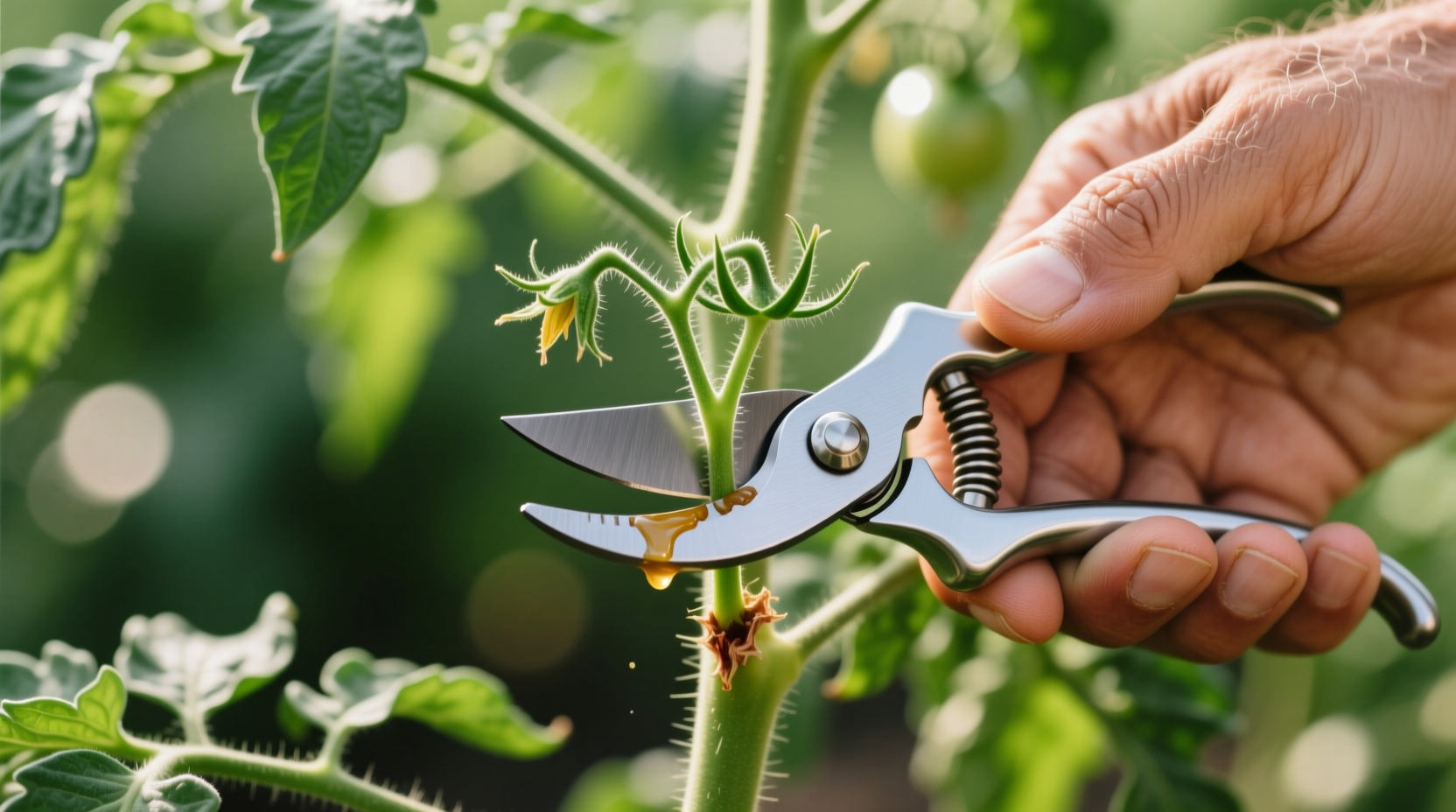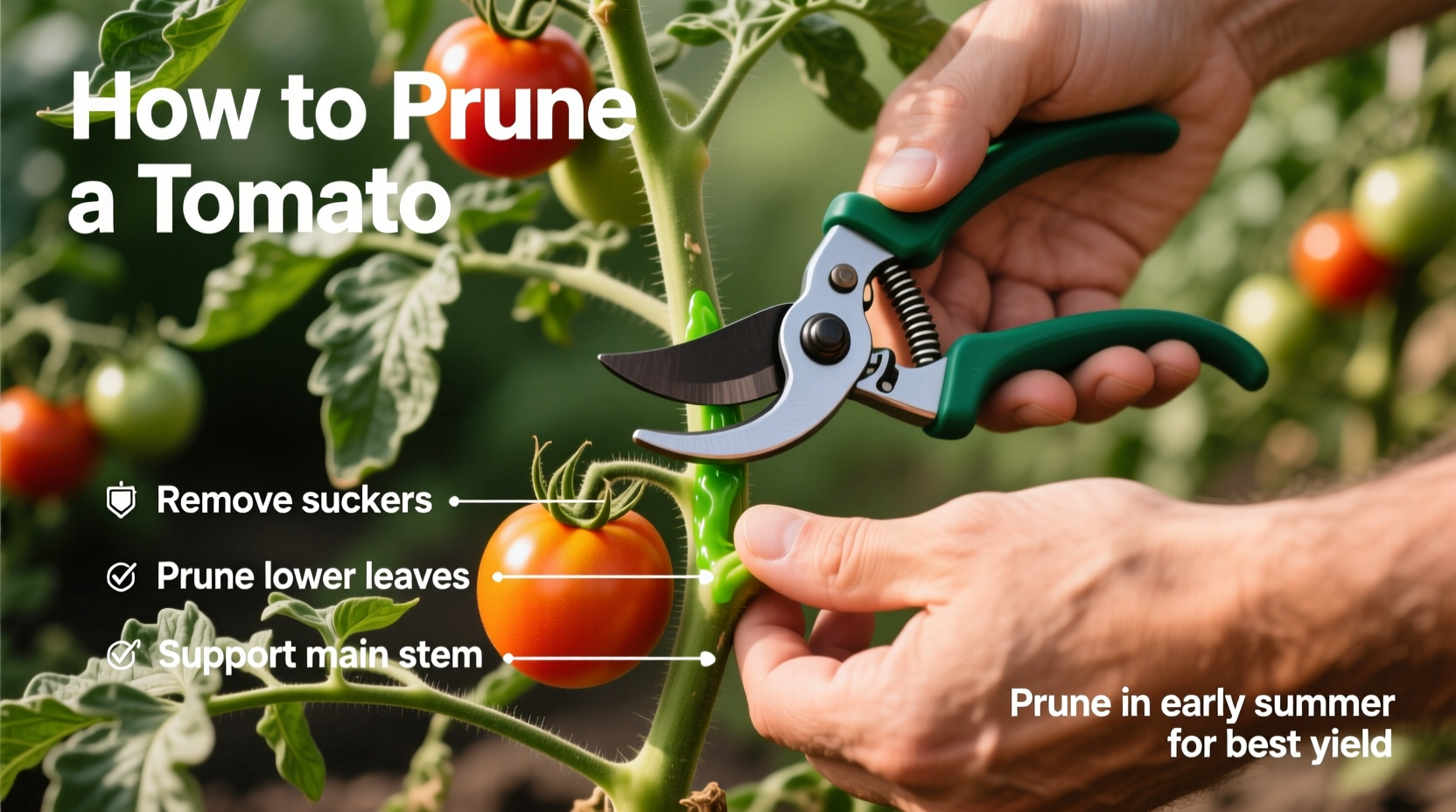Pruning tomato plants properly increases air circulation, directs energy to fruit production, and prevents disease. For indeterminate varieties, remove suckers when 2-4 inches long, keep 1-3 main stems, and prune lower leaves touching soil. Never remove more than 1/3 of foliage at once. Start pruning when plants are 12-18 inches tall and continue weekly during growing season. Proper pruning can boost your harvest by up to 30% while reducing common diseases like blight and fungal infections.
Tomato pruning isn't just optional gardening work—it's essential for healthy plants and abundant harvests. Many gardeners avoid pruning because they fear harming their plants, but when done correctly, pruning actually strengthens your tomato plants and significantly improves fruit quality. Whether you're growing beefsteak tomatoes for summer sandwiches or cherry tomatoes for salads, understanding proper pruning techniques makes the difference between mediocre and exceptional results.
Why Pruning Matters for Tomato Plants
Tomato plants naturally grow as sprawling bushes, but this wild growth pattern creates problems for home gardeners. Unpruned plants develop dense foliage that traps moisture, creating perfect conditions for diseases like early blight and powdery mildew. Research from the University of Minnesota Extension shows that properly pruned tomato plants experience up to 50% fewer disease issues compared to unpruned counterparts.
Pruning redirects the plant's energy from unnecessary leaf production to developing larger, sweeter fruits. It also improves air circulation and sunlight penetration, which are critical for photosynthesis and ripening. Commercial tomato growers have used strategic pruning for decades to maximize yield per square foot of growing space.
Identify Your Tomato Type First
Before you pick up your pruning shears, you must determine whether your tomatoes are determinate or indeterminate varieties. This distinction is crucial because pruning requirements differ significantly between the two types.
| Feature | Determinate Tomatoes | Indeterminate Tomatoes |
|---|---|---|
| Growth Habit | Bush-type, compact (3-4 ft) | Vining, continues growing (6-10+ ft) |
| Pruning Needs | Minimal pruning required | Regular pruning essential |
| Fruit Production | All ripen within 2-3 weeks | Continuous production until frost |
| Common Varieties | Roma, Celebrity, Bush Early Girl | Beefsteak, Cherokee Purple, Sungold |
Determinate varieties set all their fruit at once and then stop growing, making extensive pruning counterproductive. Indeterminate varieties continue growing and producing fruit throughout the season, requiring regular pruning to maintain productivity and plant health.
Essential Tools for Proper Tomato Pruning
You don't need expensive equipment, but having the right tools makes pruning more effective and prevents disease transmission:
- Sharp bypass pruning shears (disinfected with 10% bleach solution between plants)
- Gardening gloves (to protect hands from tomato plant oils that can cause skin irritation)
- Clean rag for wiping tools between cuts
- Small container for collecting pruned material
Never use household scissors or dull tools, as they crush stems rather than making clean cuts. The Oregon State University Extension recommends disinfecting tools between plants when disease is present to prevent spreading pathogens.
When to Start Pruning Tomato Plants
Timing your pruning correctly prevents stress and maximizes benefits. Follow this seasonal timeline for best results:
| Plant Stage | Timing | Action Required |
|---|---|---|
| Establishment Phase | 2-3 weeks after transplanting | Remove yellowing lower leaves touching soil |
| Active Growth | When plants reach 12-18 inches tall | Begin removing suckers on indeterminate varieties |
| Flowering Stage | When first flowers appear | Prune excess foliage blocking sunlight to fruit clusters |
| Late Season | 4-6 weeks before first frost | Top plants to direct energy to ripening fruit |
Avoid pruning during wet conditions or extreme heat (above 90°F/32°C), as this stresses plants and increases disease risk. Early morning is the ideal time for pruning when plants are hydrated but before temperatures rise.
Step-by-Step Pruning Process for Indeterminate Tomatoes
Follow these steps for effective pruning that maximizes your harvest:
- Identify suckers - Locate the small shoots growing in the V-shaped junction between main stem and branches
- Check sucker size - Remove when 2-4 inches long (easier to pinch off and heals faster)
- Choose your training system - Single stem (1 main leader), double stem (1 main + strongest sucker), or Missouri pruning (partial removal)
- Remove lower leaves - Cut all leaves touching soil or within 6-8 inches of ground
- Thin dense areas - Remove interior leaves blocking sunlight to fruit clusters
- Clean up - Immediately remove all pruned material from garden area
For Missouri pruning (recommended in hot climates), pinch only the top few leaves of each sucker rather than removing the entire sucker. This provides some shade to developing fruit while still controlling excessive growth.

Avoid These Common Pruning Mistakes
Even experienced gardeners make these critical errors that reduce harvests:
- Over-pruning - Removing more than 1/3 of foliage at once stresses plants and exposes fruit to sunscald
- Pruning determinate varieties - These bush-type tomatoes need minimal pruning beyond removing diseased leaves
- Pruning during wet weather - Creates entry points for fungal diseases
- Using dirty tools - Spreads diseases like bacterial spot between plants
- Leaving stubs - Creates dead tissue that invites pests and disease
The University of Illinois Extension notes that excessive pruning can reduce yields by up to 20% while increasing sunscald damage on developing fruit. Always leave enough foliage to shade fruit from intense midday sun.
Regional Considerations for Tomato Pruning
Your climate significantly impacts pruning strategy. Gardeners in different regions should adjust their approach:
- Humid climates (Southeastern US): Prune more aggressively to improve air circulation and prevent fungal diseases. Remove lower leaves weekly.
- Arid climates (Southwestern US): Practice Missouri pruning to maintain some leaf cover that protects fruit from sunscald.
- Cool climates (Pacific Northwest): Delay major pruning until plants are well-established to maximize leaf surface for photosynthesis.
- Container gardening: More frequent pruning needed due to restricted root space—keep to single stem for best results.
According to research from the California Tomato Research Institute, gardeners in coastal regions with moderate temperatures can prune less aggressively than those in inland areas with extreme temperature fluctuations.
Post-Pruning Care for Maximum Results
Pruning creates wounds that need proper care to heal quickly and prevent disease:
- Water at the base of plants (never overhead) to keep foliage dry
- Apply balanced fertilizer 3-5 days after pruning to support new growth
- Monitor for signs of stress (wilting, yellowing) for 48 hours after pruning
- Continue regular pest monitoring as pruning can temporarily make plants more vulnerable
Within 7-10 days, you should notice new growth emerging from pruning sites. This is a positive sign that your plants are recovering well and redirecting energy to fruit production.
Troubleshooting Common Pruning Issues
Even with careful pruning, problems can occur. Here's how to address them:
- Yellowing leaves after pruning: Usually temporary stress. Ensure consistent watering and avoid additional pruning for 7-10 days.
- Slow healing cuts: Could indicate disease. Remove affected branches completely and disinfect tools.
- Reduced fruit set after pruning: You likely removed too much foliage. Allow more leaves to remain near fruit clusters next time.
- Excessive sucker regrowth: Some varieties naturally produce more suckers. Increase pruning frequency to weekly during peak growth.
Remember that some leaf yellowing after pruning is normal as the plant redirects resources. However, widespread yellowing or spotting indicates a problem requiring attention.
Final Pruning Tips for Abundant Harvests
Implement these professional techniques to maximize your tomato yield:
- Prune in the morning when plants are hydrated but before heat builds
- Always remove leaves showing any disease symptoms immediately
- For container tomatoes, restrict to one main stem for best results
- Stop major pruning 4-6 weeks before first expected frost to focus energy on ripening existing fruit
- Never remove more than 20-25% of foliage in a single pruning session
With proper pruning technique, your tomato plants will produce larger, sweeter fruit while remaining healthier throughout the growing season. The initial effort pays dividends in both quantity and quality of harvest—most gardeners see noticeable improvements in their second season of proper pruning as they refine their technique for their specific varieties and growing conditions.











 浙公网安备
33010002000092号
浙公网安备
33010002000092号 浙B2-20120091-4
浙B2-20120091-4